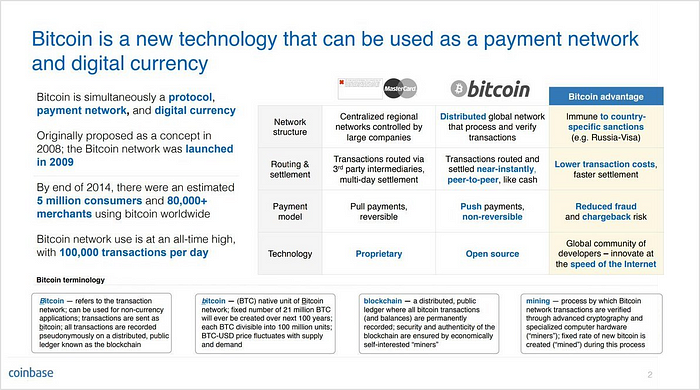They say Bitcoin can’t be stopped. Just like there’s no way you can stop two people sending encrypted messages to each other, so — they say — there’s no way you can stop the Bitcoin network.
There’s no CEO to put on trial, no central server to seize, and no organisation to put pressure on. The Bitcoin network is, fundamentally, just people sending messages to each other, peer to peer, and if you knock out 1 node on the network, or even 1,000 nodes, the honey badger don’t give a shit: the other 10,000+ nodes keep going like nothing happened, and more nodes can come online at any time, anywhere in the world.
So there you have it: it’s thousands of people running nodes — running code — and it’s unstoppable… therefore Bitcoin is unstoppable code. Q.E.D., case closed, no further questions Your Honour. This money is above the law, and governments cannot possibly hope to control it, right?
Wrong.
Bitcoin Is Más Complicado Than That, Señor
“Oh what, you’re gonna say governments can ban it? Big deal. Sure, that will hurt the price a bit in the short run… but it’ll keep going, you can’t actually kill it. Eventually it takes over. Government-backed money is a white dwarf, heading for a black hole. That’s physics. It’s inevitable.”

Also wrong. Well, not completely wrong — the part about being able to ‘hurt the price a bit’ was correct. We’ll keep that up our sleeve for later.
There are two important things to remember when you’re attacking Bitcoin:
- It’s not just a network, it’s money. The whole system is held together by a core structure of economic incentives which critically depends on Bitcoin’s value and its ability to function for people as money. You can attack this.
- It’s not just code, it’s physical. Proof-of-work mining is a real-world process and, thanks to free-market forces and economies of scale, it results in large, easy-to-find operations with big energy footprints, tightly bottlenecked supply chains, and no defence. You can attack these.
If you can exploit the practical reality of the system and find a way to reduce it to a state of total economic dysfunction, then it doesn’t matter how resilient the underlying peer-to-peer network is, the end result is the same — you have killed Bitcoin.
In other words, the 10,000+ nodes that make up the Bitcoin network can be as honey-badger-like as they want, but if the core structure of incentives and assurances collapses, all of those nodes will just be unstoppably messaging each other about the ownership history of 21 million units of a dead and valueless artefact.
So forget bringing down the network, because that’s just a distraction. The way to kill Bitcoin is to attack it on the above two fronts, entirely within the network rules. The code doesn’t need to be stopped.

Become The Teapot
So how do you kill Bitcoin from within the network rules and without stopping the code?
First things first: you can’t just impose anti-money-laundering (AML) laws on exchanges and other businesses which handle cryptocurrency, slap a capital gains tax on traders, and be done with it. Trying to treat Bitcoin like the banking system is the opposite of becoming the teapot.
The entire point of Bitcoin is to neutralise government controls on money, which includes AML and ultimately taxes. Notice that there’s no great technological difficulty in allowing for the completely unrestricted anonymous sending of a fixed-supply money — the barrier is legal and societal, because of the practical consequences of doing that.
So the cooperation of the crypto world with the law is a temporary arrangement, and it’s not an honest handshake. The right hand (truthfully) expresses “We will do everything we can to comply” while the left hand is hard at work on the technology which will make that compliance impossible.

Sure, Bitcoin might be pretty traceable now, and sometimes it even helps with finding criminals who don’t have the technical savvy to cover their tracks, but you’ll be fighting a losing battle over time as the protocol is upgraded with stronger, more convenient privacy tooling. It’s already happening, and 10 years from now, if all goes to plan, the ability to trace funds won’t be there.
Likewise, and for similar reasons, you will not be able to censor the transactions of violent criminal syndicates, human traffickers, ransomware operators, etc. like you can within the banking system, or seize their funds on capture like you can with cash. Regulating miners and requiring them to not process transactions from blacklisted addresses won’t work: it’s easy (and profitable) to circumvent this kind of censorship in an anonymous world. There will be no way to prove that any such law was broken.

It’s important to understand that Bitcoin’s ability to indiscriminately serve the worst and most socially destructive human beings on the planet with a way of storing and transferring value electronically, out of reach of authorities, (like physical cash, only much better), is a foundational test of its value. If it can’t do that, it’s worthless.
This point is easy to lose sight of so it’s worth re-emphasising: the sole purpose of blockchain technology is to remain completely open and neutral, and resist any kind of action by an authority, government or otherwise. The ability to subvert government controls like AML laws and taxes isn’t just an edgy Libertarian talking point, it’s a technical constraint on the system — it’s the only reason Bitcoin’s ridiculously inefficient design makes sense and has any value.
That’s not just an opinion, it’s a fact of engineering: there are much better, more efficient, more cost-effective ways of securing and operating a ledger, to achieve any purpose, if you want to work within the law. Neutralising the capacity for anyone to take effective governmental action is what a blockchain is for, and there is nothing other than that which it does well.
(If you were wondering why, after 11 years and tens of billions of dollars poured in, no real use-cases have emerged for blockchain technology when we were told it’s such a mind-blowing innovation, that’s the reason).
So yeah: half measures like AML and censorship aren’t going to cut it. If you want to kill Bitcoin, that means taking bigger action. Realistically, a widespread ban in the major economies of the world would probably be enough to condemn the system to death (for technical reasons we can go into another time). But if the goal is to kill Bitcoin unambiguously, you can take the gloves off and launch an attack, forcing the system into disequilibrium and inducing economic collapse.
Fortunately that’s relatively straightforward and, as it turns out, surprisingly inexpensive to do.
